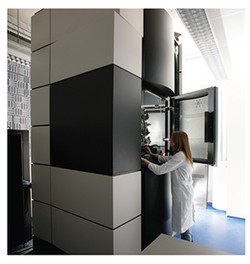Visualization of the SARS-CoV-2 virulence factor Nsp1 hijacking human ribosomes
LMU study uses high-end cryo-electron microscopy to discover potential new drug target against COVID-19
17.07.2020
The severe acute respiratory syndrome-coronavirus 2 (SARS-CoV-2), the cause of the COVID-19 pandemic, has infected millions worldwide with a death toll amounting to hundreds of thousands. Neither vaccines nor efficient drugs are available so far. Researchers from LMU Gene Center and university of Ulm have determined how the pandemic coronavirus SARS-CoV-2 inhibits the synthesis of proteins in infected cells and shown that it effectively disarms the body’s innate immune system.
A major virulence factor of SARS-CoVs is the nonstructural protein 1 (Nsp1). From the outbreak of the related SARS-CoV more than 10 years ago, Nsp1 was known to suppress host protein production upon association with the 40S ribosomal subunit by an unclear mechanism. The small 40S and the large 60S ribosomal subunits form the cellular translation machinery, the 80S ribosome, that produces essentially all proteins using mRNA as a template.
 The Beckmann group has studied ribosomes and translation for decades and, together with the Sparrer group of Ulm University, decided to analyze Nsp1 from the current Coronavirus in more detail. They found that the Nsp1 protein from pandemic SARS-CoV-2 binds to both, 40S subunits and to 80S ribosomes. As a result, translation of cellular mRNA is shutdown both, in vitro and in human cells. By high-end cryo-electron microscopy (cryo-EM) they discovered that the C-terminus of Nsp1 inserts into the mRNA entry channel as a hairpin of alpha-helices and blocks it for mRNA, thus explaining translation inhibition by Nsp1. Notably, binding in this channel depended strictly on two specific amino acid side chains of Nsp1, which were inserted into a distinct pocket on the ribosome. These important molecular details were resolved at a resolution of 2.6 Å, which was only possible with the recently established high-end equipment of the Gene Center cryo-EM facility, jointly funded by the LMU and the Deutsche Forschungsgemeinschaft (DFG). Moreover, a cryo-EM inventory of native Nsp1-ribosome complexes, which were purified from transfected human cells, revealed 40S and unusual 80S ribosomes, all displaying the same mode of Nsp1 blocking the mRNA entry channel. Also in human cells, the Sparrer group of Ulm University observed that shutdown of translation by Nsp1 is responsible for a near complete inhibition of the innate immune response, one of the major cellular virus defense systems, thereby contributing to the immune evasion strategy of the virus. Thus, having deciphered in detail the molecular basis of the inhibitory mechanism of Nsp1 may serve as starting point for structure-based drug design against SARS-CoV-2.
The Beckmann group has studied ribosomes and translation for decades and, together with the Sparrer group of Ulm University, decided to analyze Nsp1 from the current Coronavirus in more detail. They found that the Nsp1 protein from pandemic SARS-CoV-2 binds to both, 40S subunits and to 80S ribosomes. As a result, translation of cellular mRNA is shutdown both, in vitro and in human cells. By high-end cryo-electron microscopy (cryo-EM) they discovered that the C-terminus of Nsp1 inserts into the mRNA entry channel as a hairpin of alpha-helices and blocks it for mRNA, thus explaining translation inhibition by Nsp1. Notably, binding in this channel depended strictly on two specific amino acid side chains of Nsp1, which were inserted into a distinct pocket on the ribosome. These important molecular details were resolved at a resolution of 2.6 Å, which was only possible with the recently established high-end equipment of the Gene Center cryo-EM facility, jointly funded by the LMU and the Deutsche Forschungsgemeinschaft (DFG). Moreover, a cryo-EM inventory of native Nsp1-ribosome complexes, which were purified from transfected human cells, revealed 40S and unusual 80S ribosomes, all displaying the same mode of Nsp1 blocking the mRNA entry channel. Also in human cells, the Sparrer group of Ulm University observed that shutdown of translation by Nsp1 is responsible for a near complete inhibition of the innate immune response, one of the major cellular virus defense systems, thereby contributing to the immune evasion strategy of the virus. Thus, having deciphered in detail the molecular basis of the inhibitory mechanism of Nsp1 may serve as starting point for structure-based drug design against SARS-CoV-2.

